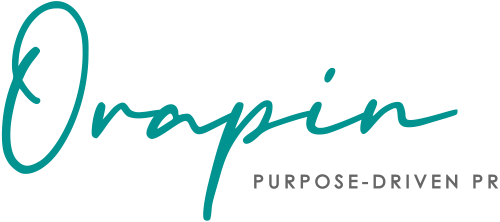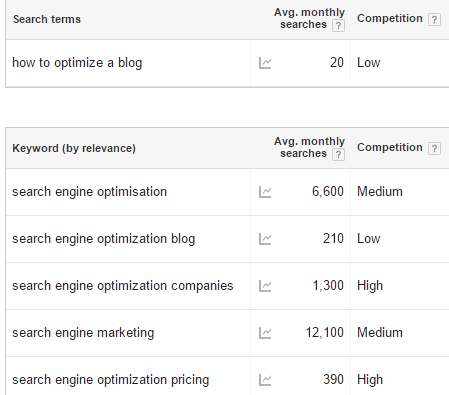Each month, we feature a guest blog post with success stories and other great information and advice we think thriving local businesses would care about. This month’s post comes from Natalie Henley of Volume Nine who gives extremely helpful information about optimizing blog posts.
When Michelle asked me to tackle this topic for her readers, I was really struck by how much the PR & SEO world have collided in the past few years. I started my career in PR & hopped the fence over to SEO and digital marketing about 6 years ago. At that time, PR was barely digital and in many cases we steered clients away from blogging in an effort to help them control their messaging and tone.
Now, it’s a totally different ball game, and your blog is not only a critical communication point for spring-boarding PR campaigns and growing your brand, it’s also an essential component of a successful SEO campaign.
Can Blogging Really Help a B2B?
So I’d like to start by giving a window into what your blog is capable of.
Two years ago at Volume Nine, we were pretty skeptical about blogging and the ROI of a content marketing program. However, we knew this was where our industry was headed so we jumped in. We started ramping-up our content program slowly throughout 2014, then kicked it into high-gear January of 2015.
Here’s how the math worked out – we experienced a 567% increase in organic traffic from January 1 – May, 15 when comparing 2015 & 2013.
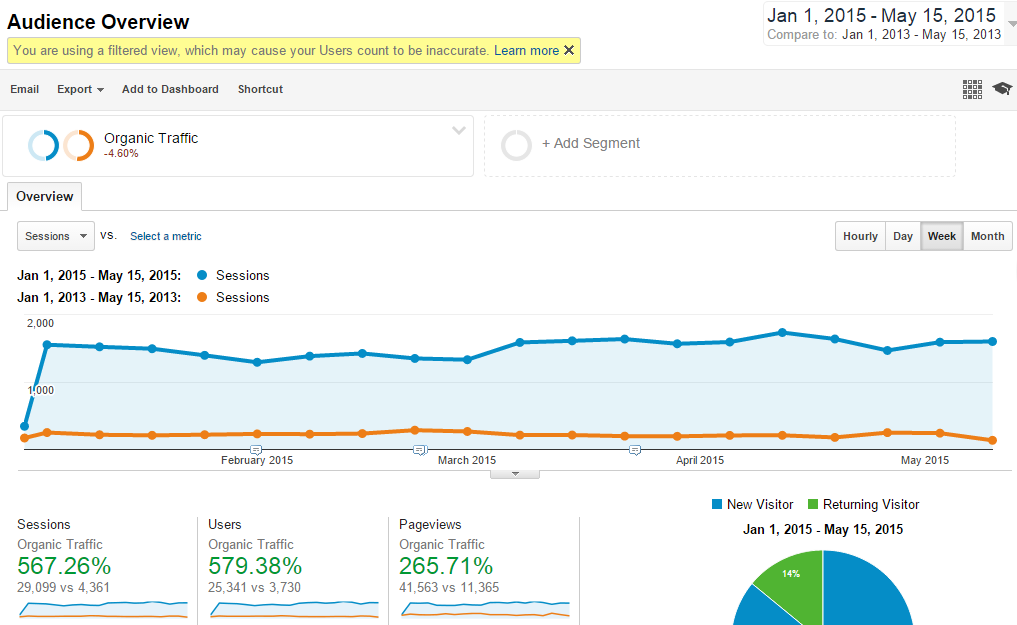
On top of that, we went from 23 conversions in those 4.5 months in 2013 to more than 1,000 in 2015:

In addition to just sheer traffic & conversions, our blogs have been picked up and linked to from dozens of thought leaders, as well as we’ve been asked to participate in various speaking events. In other words, the benefit to our brand has been tremendous.
So, I’m not trying to brag about how awesome we are at blogging – I’m honestly saying that if you are business owner or marketing executive that’s skeptical of putting extra effort into your blog, I was in your shoes two years ago and believe me it’s freaking worth it.
How we think about optimization
So, when you are thinking about “SEOing” a blog post, the first thing I’d say is to always remember where SEO belongs in this process. In general, optimizing a blog is just one of many ways you can amplify your content. The main key is to develop a great piece of content first, then worry about optimization or amplification second.
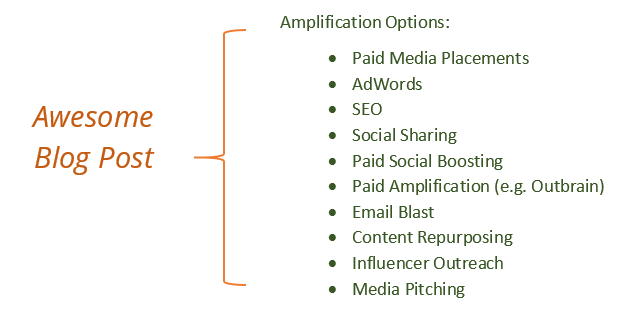
Main Secret: Quality is King
Let me be totally honest here – we wrote blogs in 2013 but they just weren’t very good. It’s fair to say we attempted to cheat the system with thin content, outsourced blogs and vague advice for in-depth concepts… we were idiots. The main difference in our program today is that we now take the time to write great content we know our users will find a lot of value in – not to game the system or gain rankings for a keyword to trick them into visiting our site. If you are struggling framing your mind around how to do these, we’ve got an in-depth run down on developing a quality blog for SEO.
So, once you’ve written a great post that sufficiently addresses the topic, then and only then are you ready to optimize the sucker!
Optimizing a Blog Post – The Process
So, if you are up to date on current optimization techniques for website pages, you may have realized it’s a ton of work. However, breathe easy, optimizing a blog post is a little less work than optimizing your services pages (wahoo!). By the way, visit our site if you’d like a full run down for how to optimize your website content (or if you just want to get a sense of what we are talking about when we say it’s a lot of work).
Keyword Research
So, before you start optimizing you obviously are going to need a keyword phrase. There are several free tools you can use to find a keyword phrase, including:
- Tool #1: Google Keyword Planner – A “go to” in the industry and also free, this tool will give you some general ideas of keywords around the topic of your blog post. https://adwords.google.com/KeywordPlanner
- Tool #2: Google Instant Search – Basically start typing in the topic of you blog post into a search bar and see what shows up. Google pulls this list based on the most recent trends in searching topics, so it’s a great way to stay on the pulse of search.
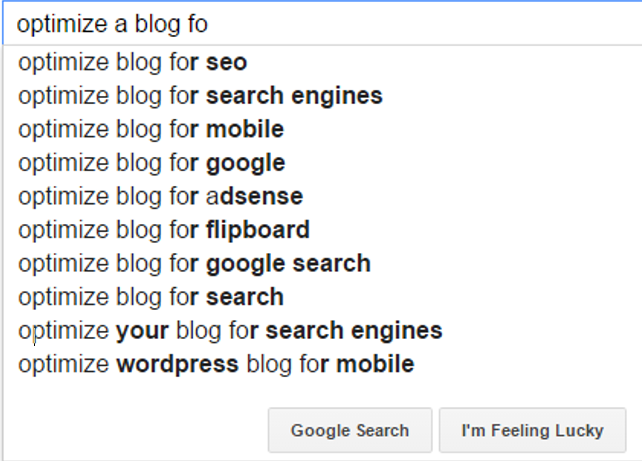
Tip for Finding the Right Keyword:
Most blog posts lend themselves to longer, more informational keyword phrases. For example, if you write a blog post about “Where to Buy Coffee in Denver” your keyword phrase won’t be “Coffee Denver,” it will more likely be something like “Best Coffee Places in Denver.”
How to Optimize the Content
Now that you’ve got your keyword phrase, it’s time to get your blog post optimized! There are 4 big places you want to focus on when optimizing your blog:
#1 Page Title
We believe this is darn important, and if you have a WordPress blog we strongly recommend utilizing a plugin like SEO by Yoast to make this easier for you to do each time.
Tips: Aim for under 60 Characters & lead with your keyword phrase.
Example:
- Good: How to Optimize a Blog Post | Volume Nine
- Bad: Volume Nine Blog Post Detailing Steps for Optimizing a Blog for SERPS
- Ugly: Blog Post, SEO, SEO for Blog Posts, V9SEO, Blog Post Optimization, Search Engine Optimization
#2: Meta Description
Ok, this doesn’t affect your SEO ranking, however it’s an important element in gaining click through rate on your blog.
Tips: Include the keyword phrase once in your meta description and write it like a marketer, not like a robot.
Example
- Good: “A quick and useful guide of how to optimize your blog posts before publishing your content. Take advantage of these tips!”
- Bad: “When Michelle asked me to tackle this topic for her readers, I was really struck by how much the PR & SEO world have collided in the past few years. I started my career in PR & hopped” (aka I didn’t feel like writing a meta description, so I left it blank and Google just picked up the first few lines).
- Ugly: “CLICK ON THIS POST ABOUT HOW TO OPTIMIZE A BLOG POST”
#3: Alt Text
If you haven’t caught on, readers love images. When you upload images into your blog post, try to avoid the temptation of skipping that optional “Alt Text” field.
Tips: Don’t over complicate it – describe the image, don’t stress about putting your keyword in there.
Example
- Good: “Google Analytics Organic Traffic Screenshot”
- Bad: “Optimize a Blog Post Jpeg 1”
- UGLY: “ “ (aka blank)
#4: Internal Links
Incorporate helpful links in your content to give your readers additional places to go for additional information on your topic. Please note this doesn’t mean link back to a bunch of your service pages – your blog shouldn’t be riddled with links and it’s not a terrible thing to link off to a different third party site.
Tip: Don’t use “click here” as your anchor text (readers have figured out what the blue underlined text is).
- Good: Not sure what to blog about? Here’s a few ideas of how to create a newsworthy event for your business.
- Bad: Not sure what to blog about? Here’s our home page that is likely not going to give you much help in the context of this sentence.
- Ugly: Not sure what to blog about? Or maybe you need an SEO audit? Or perhaps a Denver PR Company? (You get the idea.)
…and that’s it!
Ok, Let’s Wrap It Up
At the end of the day, the dirty secret to optimizing a blog post is that it’s not that hard. Spend your time writing a high quality post & finding your unique angle that will engage your audience – don’t spend your time trying to cram a keyword phrase into the content.
The Obligatory CTA
If you can’t figure out what the heck to write, then consider working with professionals (like *cough* *cough* Orapin or V9).
Are you in the trenches and have more questions about optimizing your blog posts or content? Well by golly you are in luck – leave a comment on this blog and we’ll get it answered for you!
Author: Natalie Henley
Natalie Henley is an energetic & widely acclaimed speaker, trainer, and consultant. She has been in the industry for over 6 years and specializes in Digital Marketing Strategy. With an extensive background in market research & P.R. for Fortune 50 companies, Natalie specializes in Digital Marketing Strategy.
Natalie is President of Volume Nine, Denver’s largest SEO-only firm. Due to Volume Nine’s innovative strategies and great client results, they have been dubbed one of Denver’s fastest growing companies 3 years in a row.
Natalie has spoken for numerous groups and conferences, including most recently ClickZ, Search Engine Strategies, Search Engine Marketing Professionals Organization (SEMPO), Colorado Alliance of Illustrators, Vistage International and many others. She has also been published & quoted in numerous publications including Home Business Magazine, Speaker Magazine, and Inc.com.

Rhiannon Hendrickson is the founder and CEO of Orapin, which helps purpose-driven organizations transform their random acts of PR into a strategic, consistent approach that generates greater awareness and impact. She has worked with organizations of all sizes across myriad industries and causes to develop earned media and thought leadership programs that generate awareness, engagement, and, ultimately, support for those that are making a meaningful impact.
